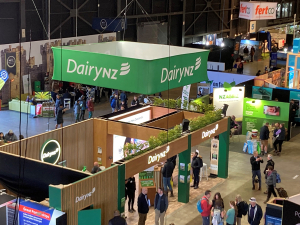Dairy sector profit still on the table, but margin gap tightens
DairyNZ’s latest Econ Tracker update shows most farms will still finish the season in a positive position, although the gap has narrowed compared with early season expectations.
 DairyNZ launched a new resource at National Fieldays, to help farmers better understand the current economic environment.
DairyNZ launched a new resource at National Fieldays, to help farmers better understand the current economic environment.
Farmers are facing increased costs and are focused on managing these at the start of the new dairy season.
To support farmers, DairyNZ launched a new resource at National Fieldays, to help them better understand the current economic environment.
“Every farm is different but, given the scale of cost increases in the past few seasons, many farms will be feeling the current profit squeeze,” explains DairyNZ chief executive Tim Mackle.
“They will likely be starting the season with inflation, farm costs and milk prices front of mind, and considering how to approach the year ahead.”
DairyNZ’s data has shown that, on average, farm costs increased by around 13% between the past two seasons (2021/22 and 2022/23) and around 33% over the past three years. However, costs are forecast to reduce from around $9.17 kg/MS last season to around $8.96 kg/MS for the 2023/24 season.
“It is good to be seeing a slight reduction in farm expenses, particularly for urea and supplementary feed, but costs are still high. We are hearing from farmers that on-farm inflation is one of the biggest concerns impacting their profitability, as they have experienced significant price increases in the past year,” says Mackle.
“That’s why we are focused on supporting our farmers through current market conditions. We are excited to launch our new DairyNZ Econ Tracker to farmers, which provides some of the latest information on the New Zealand dairy sector, including farm economics.
“This is a central platform where farmers can gain information to help understand their operating environment, track sector trends, and then apply the information to their individual farm businesses.
The DairyNZ Econ Tracker builds on the available information from the DairyNZ Economic Survey and Dairy Statistics and provides a snapshot of the dairy sector’s economic situation.
The National Wild Goat Hunting Competition has removed 33,418 wild goats over the past three years.
New Zealand needs a new healthcare model to address rising rates of obesity in rural communities, with the current system leaving many patients unable to access effective treatment or long-term support, warn GPs.
Southland farmers are being urged to put safety first, following a spike in tip offs about risky handling of wind-damaged trees
Third-generation Ashburton dairy farmers TJ and Mark Stewart are no strangers to adapting and evolving.
When American retail giant Cosco came to audit Open Country Dairy’s new butter plant at the Waharoa site and give the green light to supply their American stores, they allowed themselves a week for the exercise.
Fonterra chair Peter McBride says the divestment of Mainland Group is their last significant asset sale and signals the end of structural changes.

OPINION: Your old mate welcomes the proposed changes to local government but notes it drew responses that ranged from the reasonable…
OPINION: A press release from the oxygen thieves running the hot air symposium on climate change, known as COP30, grabbed your…